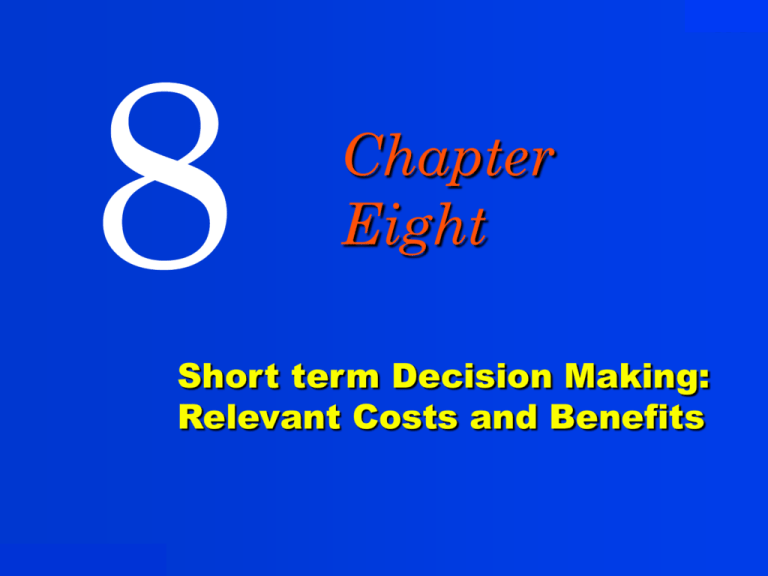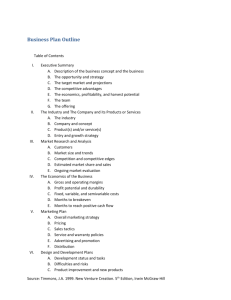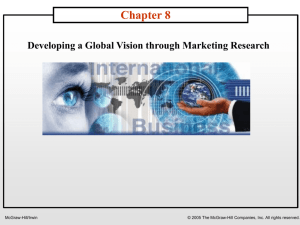Relevant Costs and Benefits
advertisement

14-1 Chapter Eight Short term Decision Making: Relevant Costs and Benefits McGraw-Hill/Irwin The Managerial Accountant’s Role in Decision Making Managerial Accountant Designs and implements accounting information system Cross-functional management teams who make production, marketing, and finance decisions Make substantive economic decisions affecting operations McGraw-Hill/Irwin 14-2 14-3 Relevant Information Information is relevant to a decision problem when . . . It has a bearing on the future, It differs among competing alternatives. McGraw-Hill/Irwin 14-4 Identifying Relevant Costs and Benefits Costs and revenues Revenue Total costs Variable costs Fixed costs Units McGraw-Hill/Irwin 14-5 Identifying Relevant Costs and Benefits Sunk costs Costs that have already been incurred. They do not affect any future cost and cannot be changed by any current or future action. Sunk costs are irrelevant to decisions. McGraw-Hill/Irwin 14-6 Relevant Costs: example You live in King City. You come to class with the GO although you have a car. A classmate that also lives in King City is willing to come with you in your car and pay 1.25 times the GO fare. Current Situation: Costs: Go bus = 4.45 Alternative situation: Revenues: 1.25 times the GO bus fare = 5.55 Costs: Gas 1 litre = 1.15 Insurance …………….? Lease payments ………? McGraw-Hill/Irwin Maximum total costs per trip: $10 Decision rule: YES if CMg > 0 14-7 Distortions in Company Reporting Accrual accounting (meaning of depreciation) Full cost reporting See Exhibit 8.1 (page 177): Full costs $2.25 Proposed selling price $2 Is the new customer offer worthwhile? Decision rule: YES if CMg > 0 McGraw-Hill/Irwin Calculate the variable costs and contribution margin 14-8 Analysis of Special Decisions Let’s take a close look at some special decisions faced by many businesses. We just received a special order. Do you think we should accept it? McGraw-Hill/Irwin 14-9 Accept or Reject a Special Order A travel agency offers Worldwide Airways $150,000 for a round-trip flight from Hawaii to Japan on a jumbo jet. Worldwide usually gets $250,000 in revenue from this flight. The airlines is not currently planning to add any new routes and has two planes that are idle and could be used to meet the needs of the agency. The next screen shows cost data developed by managerial accountants at Worldwide. McGraw-Hill/Irwin 14-10 Accept or Reject a Special Order Typical Flight Between Japan and Hawaii Revenue: Passenger $ Cargo Total Expenses: Variable expenses Allocated fixed expenses Total Profit 250,000 30,000 $ 280,000 $ 190,000 90,000 90,000 100,000 Worldwide will save about $5,000 in reservation and ticketing costs if the charter is accepted. McGraw-Hill/Irwin 14-11 Accept or Reject a Special Order Assumes excess capacity Special price for charter Variable cost per flight Reservation cost savings Variable cost of charter Contribution from charter $ 150,000 $ 90,000 (5,000) 85,000 $ 65,000 Since the charter will contribute to fixed costs and Worldwide has idle capacity, the company should accept the flight. McGraw-Hill/Irwin 14-12 Accept or Reject a Special Order What if Worldwide had no excess capacity? If Worldwide adds the charter, it will have to cut its least profitable route that currently contributes $80,000 to fixed costs and profits. Should Worldwide still accept the charter? McGraw-Hill/Irwin 14-13 Accept or Reject a Special Order Assumes no excess capacity Special price for charter Variable cost per flight Reservation cost savings Variable cost of charter Opportunity cost: Lost contribution on route Total $ 150,000 $ 90,000 (5,000) 85,000 80,000 165,000 $ (15,000) Worldwide has no excess capacity, so it should reject the special charter. McGraw-Hill/Irwin 14-14 Decisions Involving Limited Resources Firms often face the problem of deciding how limited resources are going to be used. Usually, fixed costs are not affected by this decision, so management can focus on maximizing total contribution margin. Let’s look at the following example. McGraw-Hill/Irwin 14-15 Limited Resources Let’s calculate the contribution margin per unit of the scarce resource. Products Contribution margin per unit Time required to produce one unit Contribution margin per minute ÷ Highs Webs $ 24 $ 15 1.00 min. ÷ 0.50 min. $ 24 min. $ 30 min. Highs should be emphasized. It is the more valuable use of the scarce resource the lathe, yielding a contribution margin of $30 per minute as opposed to $24 per minute for the Webs. If there are no other considerations, the best plan would be to produce to meet current demand for Highs and then use any capacity that remains to make Webs. McGraw-Hill/Irwin 14-16 Accept or Reject a Special Order With excess capacity . . . Relevant costs usually will be the variable costs associated with the special order. Decision rule: YES if CMg > 0 Without excess capacity . . . Same as above but opportunity cost of using the firm’s facilities for the special order are also relevant. Decision rules: YES if CMg – Opportunity cost > 0 YES if not the worst CMg McGraw-Hill/Irwin 14-17 Outsource a Product or Service A decision concerning whether an item should be produced internally or purchased from an outside supplier is often called a “make or buy” decision. Let’s look at another decision faced by the management of Worldwide Airways. McGraw-Hill/Irwin 14-18 Outsource a Product or Service An Atlanta bakery has offered to supply the inflight desserts for 21¢ each. Here are Worldwide’s current cost for desserts: Variable costs: Direct material Direct labor Variable overhead Fixed costs: Supervisory salaries Depreciation of equipment Total cost per dessert McGraw-Hill/Irwin $ $ 0.06 0.04 0.04 0.04 0.07 0.25 14-19 Outsource a Product or Service Not all of the allocated fixed costs will be saved if Worldwide purchases from the outside bakery. Cost per Dessert Variable costs: Direct material $ Direct labor Variable overhead Fixed costs: Supervisory salaries Equipment depreciation Total cost per dessert $ McGraw-Hill/Irwin 0.06 0.04 0.04 0.04 0.07 0.25 Savings from Outsourcing $ $ 0.06 0.04 0.04 0.01 0.15 14-20 Outsource a Product or Service If Worldwide purchases the dessert for 21¢, it will only save 15¢ so Worldwide will have a loss of 6¢ per dessert purchased. Wow, that’s no deal! McGraw-Hill/Irwin 14-21 Outsource a Product or Service Beware of Unit-Cost Data For decision-making purposes, unitized fixed costs can be misleading. McGraw-Hill/Irwin 14-22 Add or Drop a Service, Product, or Department One of the most important decisions managers make is whether to add or drop a product, service or department. Let’s look at how the concept of relevant costs should be used in such a decision. McGraw-Hill/Irwin 14-23 Add or Drop a Product Due to the declining popularity of digital watches, Swick Company’s digital watch line has not reported a profit for several years. If the digital watch line is dropped, the fixed general factory overhead and general administrative expenses will be allocated to other product lines because they are not avoidable. The equipment used to manufacture digital watches has no resale value or alternative use. McGraw-Hill/Irwin 14-24 Add or Drop a Product Sales Less variable expenses: Mfg. expenses Freight out Commissions Total variable expenses Contribution margin Less fixed expenses: General factory overhead Salary of line manager Depreciation Advertising - direct Rent - factory space General admin. expenses Total fixed expenses Net loss McGraw-Hill/Irwin Keep Watch $ 500,000 120,000 5,000 75,000 200,000 300,000 60,000 90,000 50,000 100,000 70,000 30,000 400,000 $(100,000) Drop Watch Difference 14-25 Add or Drop a Product Sales Less variable expenses: Mfg. expenses Freight out Commissions Total variable expenses Contribution margin Less fixed expenses: General factory overhead Salary of line manager Depreciation Advertising - direct Rent - factory space General admin. expenses Total fixed expenses Net loss McGraw-Hill/Irwin Keep Watch $ 500,000 120,000 5,000 75,000 200,000 300,000 60,000 90,000 50,000 100,000 70,000 30,000 400,000 $(100,000) Drop Watch $ 60,000 50,000 30,000 140,000 $(140,000) Difference $ (500,000) 120,000 5,000 75,000 200,000 (300,000) 90,000 100,000 70,000 260,000 $ (40,000) 14-26 Summary Summary Contribution margin lost if digital watches are dropped Less fixed costs that can be avoided Salary of the line manager Advertising - direct Rent - factory space Net disadvantage $ (300,000) $ 90,000 100,000 70,000 260,000 $ (40,000) DECISION RULE Swick should drop the digital watch segment only if its fixed cost savings exceed lost contribution margin. McGraw-Hill/Irwin 8 14-27 Chapter Eight Short term Decision Making: Relevant Costs and Benefits Next chapters Long term All costs are variable, therefore decisions: all costs are relevant. McGraw-Hill/Irwin 14-28 After the break: Discuss questions 2 & 10 + problem 10 Discuss and solve problems 2, 4 and 5 Next class: Second mid term exam Chapters 6, 7 and 8 Format: multiple choices McGraw-Hill/Irwin




